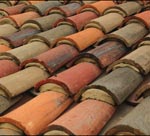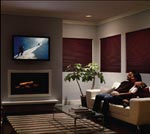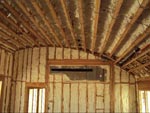BY WILLIAM JANHONEN, LEED AP, NAHB-CGP
Taking on a remodel is no easy task – and with a growing movement toward “going green,” there’s a lot more to consider. Much of it comes down to common sense building methods that utilize eco-friendly materials and green products that can increase water and energy efficiency and improve air quality. Here are some suggestions to consider when planning your expansion, remodel, or simply “changing it up” inside your home.
 Roofing
Roofing
Roofing material has gone through a true makeover and is now being made from recycled rubber, foam-backed metal, synthetic stone, and recycled concrete tiles. The days of shingles made of asphalt and cedar shakes are numbered. Today, new materials that are more durable and more cost-efficient expand roof life, use fewer resource materials, and increase energy savings.
 Windows
Windows
With the Arizona heat blazing through your windows, keeping it cool inside is the ultimate goal. Companies like Lutron have created house controls to monitor heating and cooling temperature fluctuation throughout the home by raising and lowering shades at specific times to control interior lighting and comfort needs. If you don’t want to go too high-tech, installing ENERGYSTAR windows, doors, and skylights can shrink energy bills between 7 and 15 percent. To prevent leakage, make sure all cracks are sealed during installation.
Decorating
Home interiors are becoming the playground for new designs and products. People can choose from bamboo floors, recycled concrete with imbedded melted glass countertops, repurposed furniture, antiques, and grass woven wallpaper hung with low volatile organic compound paste. The number and variety of products available for sustainable building is growing daily.
Water
In the desert, conserving water is a must. Finding ways to reduce water usage can help reduce stress on the environment, and our pocketbooks. Low-flow showerheads, faucets, toilets, ENERGYSTAR washing machines, and tankless water heaters are among the most common methods used to reduce water usage within the home. More importantly, check for water leaks within the home and around the yard.
 Lighting and Alternative Energy
Lighting and Alternative Energy
If you are thinking of changing out your lighting, consider LED lights that are lower in watts and can save lots of green for consumers. Although they have a higher initial purchase price, they can last up to 50,000 hours. ENERGYSTAR appliances use less energy and will save you money in the long run.
Using renewable energy is another effective way to lower your costs. Where it is practical, geothermal heating/cooling, wind power, and solar heating/solar photovoltaic are becoming more common. Tax incentives from the federal and state governments assist in funding these improvements – the website dsireusa.org is a mainstay for funding assistance for most home energy improvements. Also check with your utility company for assistance.
 Walls
Walls
Insulation is another option for improving both energy efficiency and indoor comfort. The type and method of installation is directly related to the area, climate conditions, and type of home. Whether you choose spray foam, packed cellulose, recycled denim, or the old standard fiberglass, you need to have a professional assess the best method and type of insulation for your home.
 Permeable Pavers
Permeable Pavers
Whether for a driveway or a patio, permeable pavers can accomplish many things, including reducing storm drain runoff, preserving our streambeds and rivers, and reducing the heat island effect. Pavers are also more aesthetically appealing, and return water to the aquifer while providing a sturdy surface. Paving surfaces can be made from grass, concrete, or mulches, among other materials. Learn more about pavers at paversearch.com.
Tips on buying an antique rug
Remain careful and thoughtful during the analysis for each piece of antique carpet you look at. You will want to touch the carpets and rugs and scrutinize them.
Tip One: Color
The range of colors makes a good starting point. The range that can be made using aniline vegetable dyes is comparatively limited. If in doubt, do a handkerchief test: aniline smells very nasty on the handkerchief.
Tip Two: Origins and Ages of Antique Carpets and Rugs
Understanding the ages and origins of the antique carpets will give you a better insight on the overall quality of the pieces.
• Antique 50 years and older
• Semi-Antique 30 to 99 years old
• Old 20 to 99 years old
• Semi-Old 10 to 50 years old
• Used 1 to 10 years old
• New 0 to 5 years old
Overall the coarser the weave, the older the rug is a very general rule. It’s also worth keeping in mind that the phrase “antique style” does not mean that a rug is an antique rug.
Tip Three: Antique Carpet and Rug Borders
Be aware of the edges and borders. The edges and borders of antique carpets should be intact. On occasion the edges and borders of antique carpets are lost or cut off the carpets on purpose. You will need to keep in mind that the edges, borders, and fringes will determine the overall cost of the antique carpet.
Tip Four: Antique Carpet and Rug Damage
There are times when antique carpets have wear and tear from use and moth damages if they are kept in storage. Make sure the person you are purchasing the antique carpet from attends to the damages before you buy the piece.
Tip Five: Reputable Antique Carpet and Rug Dealers
You will want to deal with a reputable antique carpet dealer who will stick by the prices they have marked on their carpets. You can visit with carpet and rug dealers to gain more of an education on the styles of weaving, design quality, dyes, and wools.









Thank you for mentioning just a few of the many new materials coming onto the market for interiors. The variety and number of eco-friendly materials available for finishing and furnishing the interior of you home is growing everyday- it is wonderful to see how many choices homeowners have now. The flip side of that good news, though is that it can be tricky to find the best option for you or even to know all of the choices that are out there. This is where working with a green design expert can really be invaluable- it will save countless hours and get the best results!